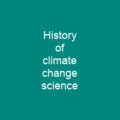Climate change

Climate change is a pressing issue that affects our planet in profound ways. It’s not just about rising temperatures; it’s about the cascading impacts on ecosystems, economies, and human health. Imagine the Earth as a delicate balance, where every action we take can tip this balance towards disaster or resilience.
Present-day climate change includes global warming, driven by human activities such as fossil fuel burning, deforestation, and agricultural practices, which release greenhouse gases. The current rise in global temperatures is exacerbated by the increasing levels of carbon dioxide in the atmosphere, now 50% higher than pre-industrial levels.
The Impact on Our Planet
Climate change has a significant impact on the environment, causing desert expansion, heat waves, wildfires, and more intense storms, droughts, and other weather extremes. It also threatens people with increased flooding, extreme heat, food and water scarcity, disease, and economic loss, with the World Health Organization calling it one of the biggest threats to global health.
Severe Consequences
The consequences of climate change can be severe, including ocean heating, acidification, and sea level rise, even if efforts to limit warming are successful. Societies and ecosystems will experience more severe risks without action, particularly for poorer communities who have a small share of global emissions but face the most vulnerability.
Phasing Out Fossil Fuels
Fossil fuel use can be phased out through conserving energy and switching to non-polluting energy sources. These include wind, solar, hydro, and nuclear power. Cleanly generated electricity can replace fossil fuels for powering transportation, heating buildings, and running industrial processes. Carbon can also be removed from the atmosphere, for instance by increasing forest cover and farming with methods that capture carbon in soil.
Historical Context
Before the 1980s, it was unclear whether increased greenhouse gases would cause global warming or cooling effects. The terms “inadvertent climate modification,” “global warming,” and “climate change” were used before they became more common. Climate change can be described as both global warming and its effects on Earth’s climate system.
Global Warming Projections
The Earth’s climate has cycled through ice ages, with temperatures reaching 0.5-1.5°C warmer than current levels during the Last Interglacial period around 125,000 years ago. Temperatures stabilized at around 11,700 years ago, but have been warming since the Industrial Revolution.
Between the 18th and 1970s, there was little net warming due to offsetting cooling effects from sulfur dioxide emissions. However, after 1970, global greenhouse gas emissions led to a marked increase in temperature, with ongoing climate changes having no precedent for several thousand years. Multiple independent datasets show a worldwide increase in surface temperature of around 0.2°C per decade.
Future Projections
The IPCC expects the 20-year average global temperature to exceed +1.5 °C in the early 2030s. Global warming projections include: 1.0–1.8 °C under low emissions, 2.1–3.5 °C under intermediate emissions, and 3.3–5.7 °C under high emissions. Future temperature increases will continue past 2100 in intermediate and high emission scenarios.
Greenhouse Gases and Their Sources
Greenhouse gases trap heat in the atmosphere, slowing its escape into space and warming the Earth’s surface over time. While water vapour and clouds primarily change with temperature, contributing to the greenhouse effect as feedbacks, human activities such as extracting and burning fossil fuels increase concentrations of gases like CO2 and methane, which are independent of temperature changes and considered external forcings.
Before the Industrial Revolution, natural greenhouse gas levels warmed the air by 33°C. Human activity has increased these levels by 50% for CO2 and 164% for methane since 1750, with CO2 levels higher than they have been in the last 14 million years. Global human-caused emissions in 2019 were equivalent to 59 billion tonnes of CO2.
Land Use and Carbon Sinks
Around 30% of Earth’s land area is unusable for humans, and deforestation is a major contributor to global warming, releasing CO2 and removing carbon sinks. Local vegetation cover impacts albedo and evaporation, and restoring degraded forests can recover their potential as carbon sinks. In tropic and temperate areas, forest restoration can make local temperatures cooler due to a net warming effect. However, at latitudes closer to the poles, this effect is reversed, resulting in cooling.
Climate Models and Projections
A climate model represents the physical, chemical, and biological processes that affect the climate system. Models include natural processes like changes in the Earth’s orbit and historical changes in the Sun’s activity. They are used to estimate the degree of warming future emissions will cause when accounting for climate feedbacks.
Environmental Effects
The environmental effects of climate change include gradual or rapid changes in oceans, ice, and weather; increased frequency of droughts, heat waves, and extreme precipitation events; rising global sea levels; shrinking and thinning of the Arctic sea ice; ocean acidification and deoxygenation.
Adaptation and Mitigation
To achieve carbon neutrality by 2050, renewable energy would need to become dominant, rising to 85% or more. Coal use would be eliminated and phased out by 2050, with electricity from renewables becoming the main source for heating and transport.
Global Efforts
The Intergovernmental Panel on Climate Change (IPCC), set up in 1988 to provide formal advice to the world’s governments, spurred interdisciplinary research. As part of the IPCC reports, scientists assess the scientific discussion that takes place in peer-reviewed journal articles.
Conclusion
The status of climate change is clear: it requires immediate and significant action from all of us. By reducing greenhouse gas emissions and increasing carbon dioxide removal, we can mitigate its worst impacts. The time to act is now, before the Earth’s delicate balance tips irreversibly.
Let’s work together to create a sustainable future for our planet and generations to come. Every small step counts in this global effort.
You want to know more about Climate change?
This page is based on the article Climate change published in Wikipedia (retrieved on November 23, 2024) and was automatically summarized using artificial intelligence.








